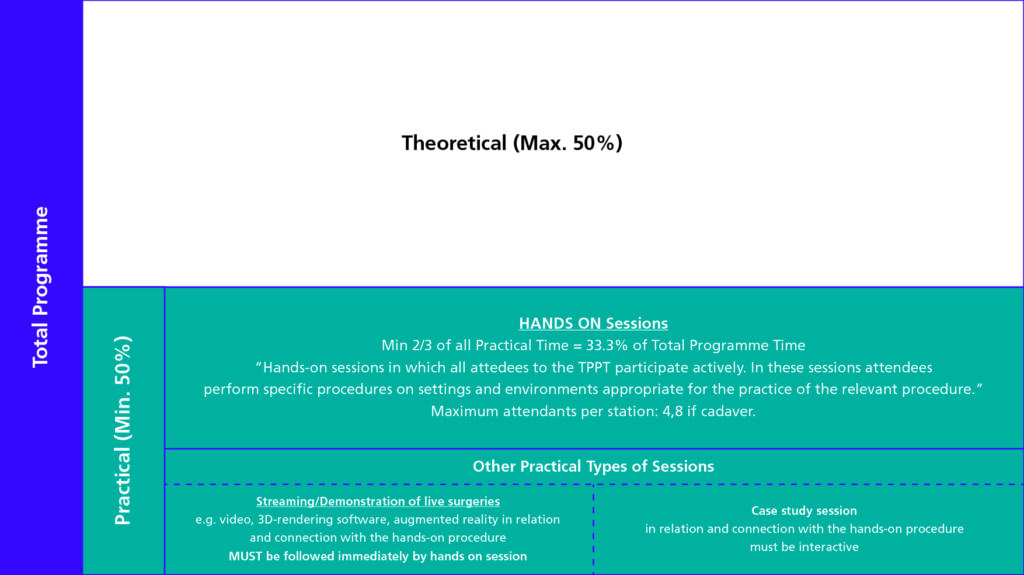Third Party Procedure Training
The Criteria Applicable to Third Party Organised Procedure Trainings
(The criteria come into effect as of 3 September 2018 for events taking place as of 1st January 2019)
Background
Chapter 2 of the MedTech Europe Code of Ethical Business Practice provides that Member Companies may support Third Party Organised Procedure Trainings either:
- via Educational Grants (in accordance with Chapter 4: Charitable Donations and Grants); OR
- by providing financial support directly to individual Healthcare Professionals to cover the cost of attendance at Third Party Organised Procedure Training sessions.
Third Party Organised Procedure Training means a type of Third Party Organised Educational Event that is primarily intended to provide Healthcare Professionals with information and training on the safe and effective performance of one or more clinical procedures in circumstances where the information and training concern:
- Specific therapeutic, diagnostic or rehabilitative procedures, namely clinical courses of action, methods or techniques (rather than the use of medical technologies); and
- Practical demonstrations and/or training for HCPs, where the majority of the training programme is delivered in a clinical environment.
For the avoidance of doubt, proctorship and preceptorship are not considered to constitute Third Party Organised Procedure Training
As recommended by the Code Committee, this exception is to be narrowly interpreted.
Cross-border and international Third Party Organised Educational Conferences need to be submitted to the Conference Vetting System (CVS).
For avoidance of doubt, as provided in Q&A 21, Proctorships and Preceptorships taking place on HCO premises are not considered to be either a Third Party Organised Educational Event or a Third Party Organised Procedural Training.
Checklist
Programme: Unlike Third-Party Organised Educational Conferences which are theoretical in nature, practical, hands-on activities comprise the majority of the programme of Third-Party Organised Procedure Trainings (“TPPTs”).
TPPTs are often referred to as “courses”, rather than conferences or seminars. Examples may include courses aimed at acquiring or improving the Healthcare Professional’s skills in minimally invasive surgery; orthopaedic trauma surgery; or the implantation of cardiac rhythm devices; etc.
The programme must be focused on acquiring specific medical skills relevant to certain medical procedures as opposed to products, or medical technologies.
The programme must include practical sessions. In order to be considered a TPPT, the practical sessions must in all cases represent more than 50 % of the full programme with hands-on sessions representing at least two-thirds of the practical sessions. This requirement must be clearly indicated in the programme of the TPPT.
Will be considered practical sessions:
- Hands-on sessions in which all attendees to the TPPT participate actively.
In these sessions attendees perform specific procedures on settings and environments appropriate for the practice of the relevant procedure.
Examples of hands-on may include surgery simulations where the technologies relevant to the specialty are practiced on cadavers; skin models; synthetic bones; cath labs; etc.
To ensure that attendants are able to fully benefit from the active aspects of hands-on sessions, no “station” (model, cadaver, table, etc.) can in principle have more than four participants.
For ethical considerations, when human cadavers are used, up to eight participants may share a “station”.
- Streaming (e.g. video, 3D-rendering software, augmented reality) or demonstrations of live surgeries followed immediately by participation of attendees in related hands-on sessions.
The sessions would only qualify as practical sessions if they are followed by hands-on sessions because they do not normally require active participation of the attendees.
Where the practical session portion of the TPPT consists entirely of participants merely watching a live surgery or a streaming of a surgery, this is not sufficient to qualify as a TPPT due to lack of active participation and hands on sessions.
- Case study sessions when the trainees learn about the procedure preparation, the tips and tricks, and complications handling of the procedure(s) from specialty expert(s). Those sessions must be interactive and based on pictures, videos, animations, 3D rending software, augmented reality, etc.

Venue: The hands-on sessions of TPPTs are typically organised in either a clinical environment or in places suitable for or set up to simulate medical procedures.
Examples of a clinical environment include hospitals or clinics, where medical treatment on real patients may be given (Operating Room, Cath. Lab).
Examples of simulation settings include conference or meeting rooms which are appropriately equipped with relevant simulation devices/systems or experimental laboratories suitable for training on cadavers, skin models, synthetic bones, live animals in accordance to applicable regulations and ethical rules, etc.
Stand-alone event: Third-Party Organised Procedure Trainings must be stand-alone. Where the majority of the Training is not given in a clinical environment, for example, where the Training is organised in connection, adjacent to or at the same time as a larger Third-Party Organised Educational Conference, that Training will not qualify as a Third-Party Organised Procedure Training as defined in the Code.
Size: Given the essential practical and hands-on element of a Third-Party Organised Procedure Training, and given that the importance of the exception is the fact that Member Companies would know the identity of the HCPs participating in the course, the size of such trainings are usually relatively small.
However, provided that the above criteria are met, size may not be a determining factor.
